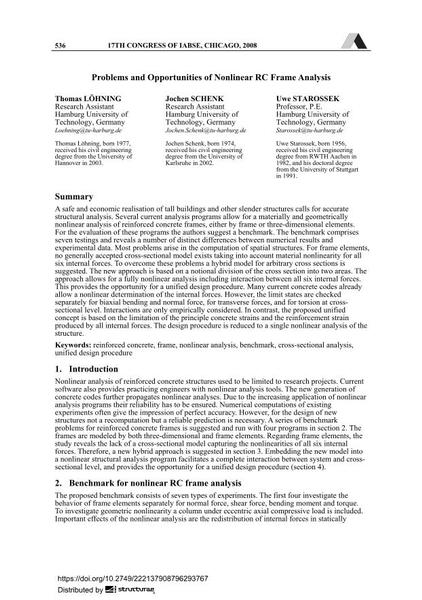Problems and Opportunities of Nonlinear RC Frame Analysis

|
|
|||||||||||
Bibliografische Angaben
| Autor(en): |
Thomas Loehning
Jochen Schenk Uwe Starossek |
||||
|---|---|---|---|---|---|
| Medium: | Tagungsbeitrag | ||||
| Sprache(n): | Englisch | ||||
| Tagung: | 17th IABSE Congress: Creating and Renewing Urban Structures – Tall Buildings, Bridges and Infrastructure, Chicago, USA, 17-19 September 2008 | ||||
| Veröffentlicht in: | IABSE Congress Chicago 2008 | ||||
|
|||||
| Seite(n): | 536-537 | ||||
| Anzahl der Seiten (im PDF): | 8 | ||||
| Jahr: | 2008 | ||||
| DOI: | 10.2749/222137908796293767 | ||||
| Abstrakt: |
A safe and economic realisation of tall buildings and other slender structures calls for accurate structural analysis. Several current analysis programs allow for a materially and geometrically nonlinear analysis of reinforced concrete frames, either by frame or three-dimensional elements. For the evaluation of these programs the authors suggest a benchmark. The benchmark comprises seven testings and reveals a number of distinct differences between numerical results and experimental data. Most problems arise in the computation of spatial structures. For frame elements, no generally accepted cross-sectional model exists taking into account material nonlinearity for all six internal forces. To overcome these problems a hybrid model for arbitrary cross sections is suggested. The new approach is based on a notional division of the cross section into two areas. Where stirrups and longitudinal bars form a reinforcement net, membrane elements are used. In the remaining area, stresses are assumed to be uniaxial. The presented model allows for a fully nonlinear analysis including interaction between all six internal forces. This provides the opportunity for a unified design procedure. Many current concrete codes already allow a nonlinear determination of the internal forces. However, the limit states are checked separately for biaxial bending and normal force, for transverse forces, and for torsion at cross-sectional level. Interactions are only empirically considered. In contrast, the proposed unified concept is based on the limitation of the principle concrete strains and the reinforcement strain produced by all internal forces. The design procedure is reduced to a single nonlinear analysis of the structure. |
||||
| Stichwörter: |
Skelettbau Stahlbeton nichtlineare Analyse
|
||||
